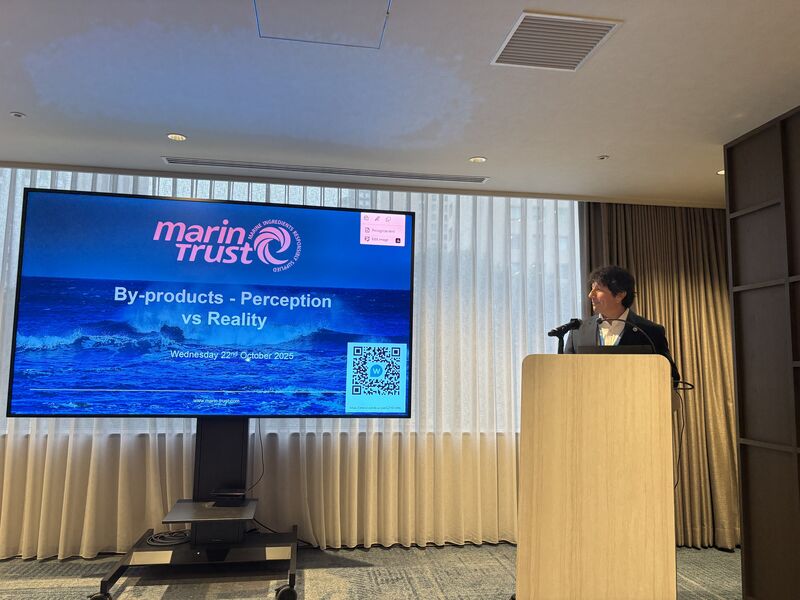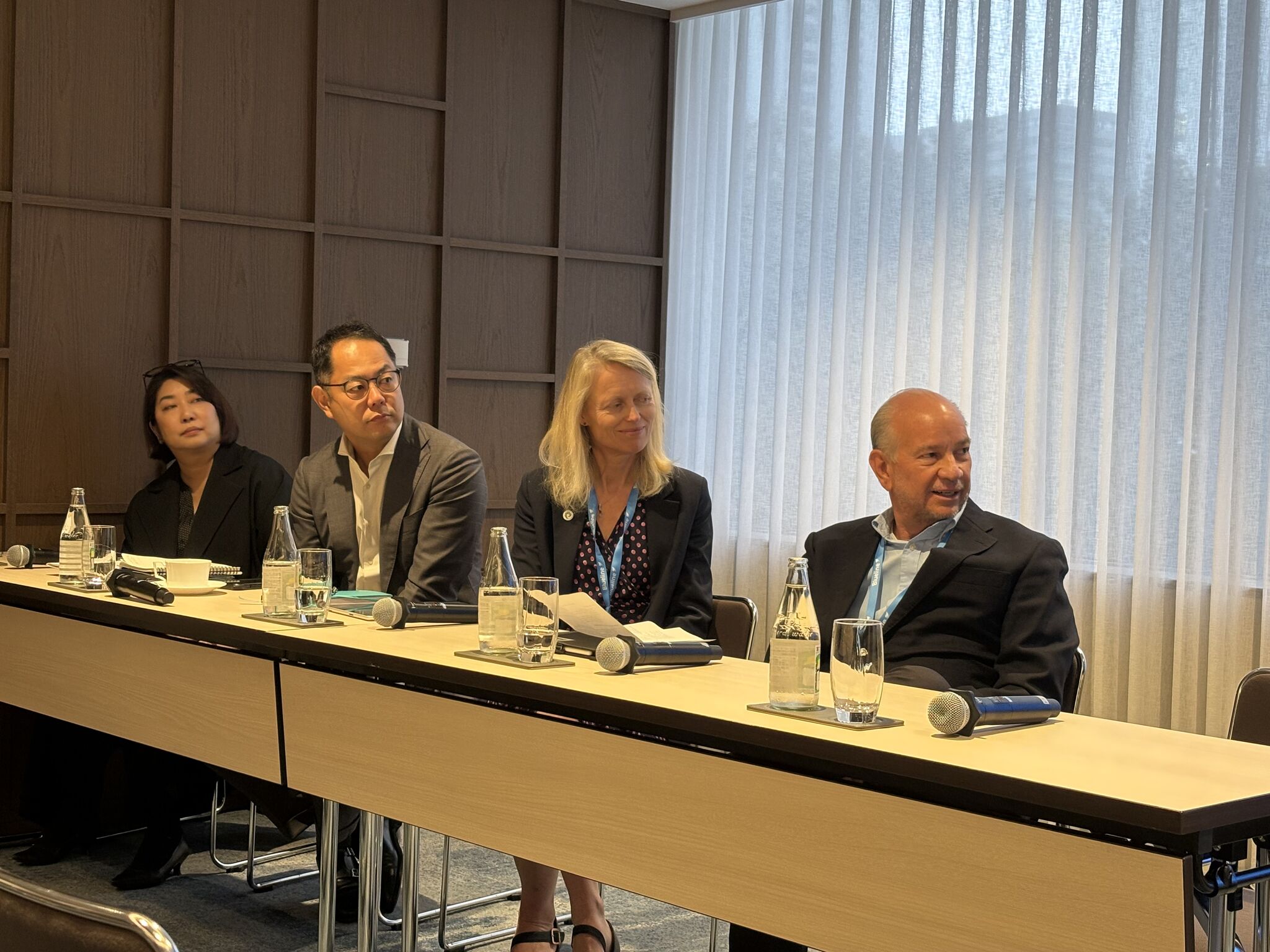MarinTrust held a “By-product: Myth versus reality” workshop in Tokyo on the 22nd October 2025, featuring:
- Francisco Aldon, CEO, MarinTrust (Moderator)
- Aiko Yamauchi, Vice President and COO of Seafood Legacy
- Armando Coppel, Director of Maz Industrial SA de CV
- Koji Yamamoto, General Manager of ASC Japan
- Job van Mil, Sustainability Specialist, Skretting, represented by Libby Woodhatch, Executive Chair of MarinTrust

The event explored the role of by-products in marine ingredient production in Asia and meeting global market demands. MarinTrust’s CEO Francisco Aldon opened the event by indicating that “byproducts can take up to 70% of the wet fish. The recovery of these materials can be through integrated companies, or from fish processors, supermarkets, restaurants. This is where the complexity comes from”. MarinTrust encourages the use of by-products and 107 factories certified under MarinTrust use by-products. “Our standard has assessed over 120 species where by-products come from”, he added.
Case study from Mexico
Presenting a case study from Mexico, Armando Coppel, Director of Maz Industrial, showed how his company has transformed by-products into high-value ingredients. Coppel noted that by-products sources and uses are diverse, with any part of the fish that is not intended for direct human consumption can be utilized in other industries such as heads, viscera, bones, trimmings, skin & rejections. They can be used as marine ingredients in feed, fertilizers, food, supplements and cosmetics. “Certain by-products from non-commercial parts of marine organisms contain the same and, in some cases, even greater potential for obtaining bioactive components as the commercial parts.”
The potential is huge, with 225 million MT of fish production in 2024, there is approximately 115 million MT of potential by-products. Maz produces over 65,000 MT of by-products annually, with 63% from tuna and 17% from cooker stickwater, processed into fishmeal, bone meal, dry hydrolysate, fish oil and much more.
Coppel stated: “90% of the byproducts come from our plants, but the complexity comes from the remainder 10%, which we have to collect and trace back to their origins. Sometimes, the cost of logistics is higher than the cost of the by-product itself.”
Benefits to investing in by-products range from added value, improved environmental footprint, supply stability, job creation, and reduced pressure on fisheries. There are however challenges, such as inefficiencies in the value chain, cold chain management and efficient processing, investment costs, recognition as high value products, and high standards to comply with international certifications.
The opportunity that by-products offer for feed
MarinTrust’s Libby Woodhatch presented Skretting’s presentation on behalf of Job van Mil, Sustainability Specialist at Skretting. She gave an overview of their strategy on marine ingredients and the use of by-products. They noted that circular ingredients are a key part of the Skretting ingredient portfolio, by-product usage in marine ingredients to growing the 40% in recent years. This trend is growing as the industry seeks to maximise resource efficiency and sustainability by reducing waste.
The requirements for by-products are the same as for whole fish. Not only on nutrition and quality, also on sustainability. "This means that we will perform supply chain due diligence and do not accept IUU or endangered species in the mix. Therefore, Traceability is key! To make sure by-products are used, us and our customers require the triple solution: Know species mix, know fishing origins, and certification".
Challenge of covering it all through certification
ASC’s General Manager for Japan Koji Yamamoto presented an overview of ASC’s approach to feed and marine ingredients. Detailing the challenge of addressing the huge impact of feed, Yamamoto noted that feed typically accounts for 50% of a farm’s total production cost, 80% of carbon footprint of seafood farming and carries social risks. ASC has implemented time-bound improvement targets for marine ingredients (towards MSC), with a Public Supplier Code of Conduct covering social and environmental impacts two steps upstream. In Japan, only a limited number of forage fisheries are taking part in the programmes recognised by ASC (i.e. FIPs, MarinTrust and MSC). However the utilisation of by-products is well-established and making up significant proportion of marine ingredients (70-80%). Yamamoto highlighted the key challenge of demonstrating low-risk on IUU and endangered species. He called for retailers to go one step beyond and encourage the use of by-products.
Traceability
Aiko Yamauchi, Vice President and COO of Seafood Legacy presented an overview of the production of by-products in Japan. Yamauchi noted that the country has a long history of commitment to circular economy, with the use of by-products in feed for domestic farms being discussed and increasing used since 2013. However challenges remain, such as addressing IUU and endangered species risks, prioritizing certified or equivalent seafood products, addressing HR/labour practices, and implementing robust traceability and transparency. Japan Fisheries agency is implementing a strategy to promote aquaculture as a growth industry and advancing food recycling is a key requirement. Japan can also bring innovative solutions to overcome the challenges with support from global stakeholders, and market players need to be part of the effort for traceability and operational improvements.

In the event’s Q&A session, Libby Woodhatch touched on Version 3 of the MarinTrust standard, which includes key data elements for bringing people alongside with MarinTrust regarding traceability assurances.
The discussion also addressed the ASC Farm and the ASC Feed standards. The Feed standard considers feed ingredients and among those, marine raw materials produced from whole fish. Fish byproducts don’t count as part of the limit that is set in the ASC Feed standard.
Francisco Aldon concluded insisting on the role of innovation to foster the use of by-products and advanced traceability. Collaboration is instrumental between sectors (fisheries and direct human consumption ; fisheries and aquaculture). "There is no waste: only misused resources."
